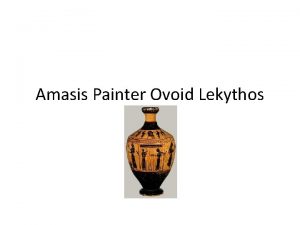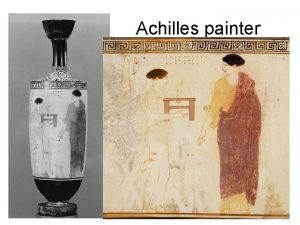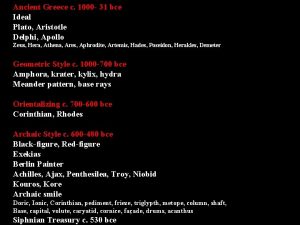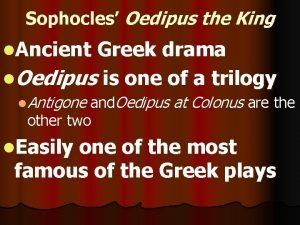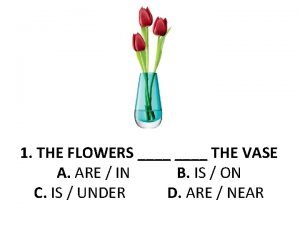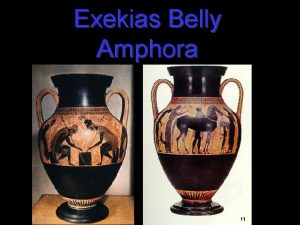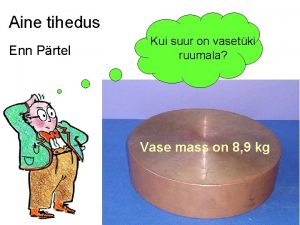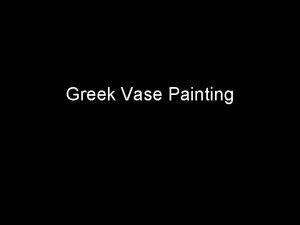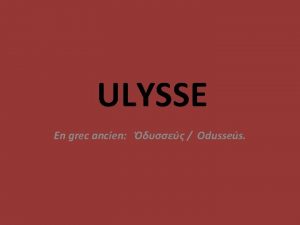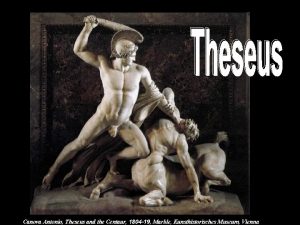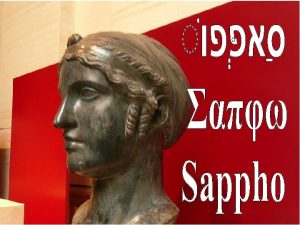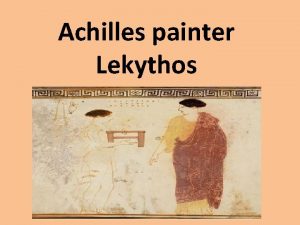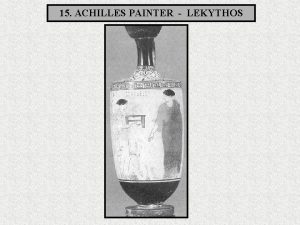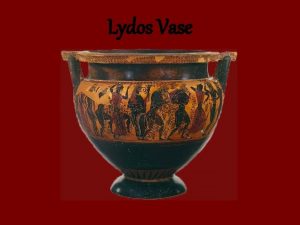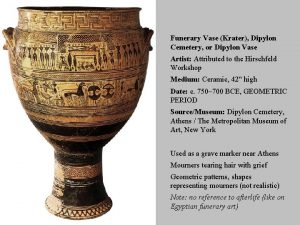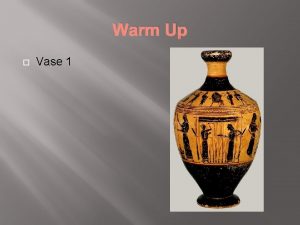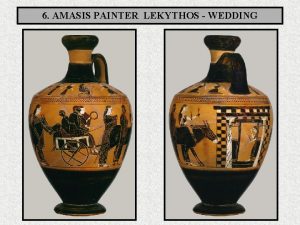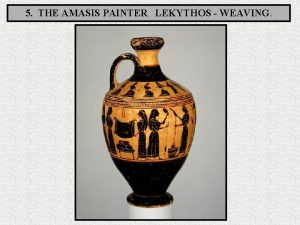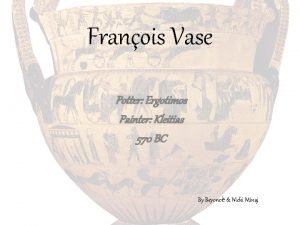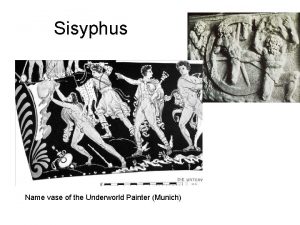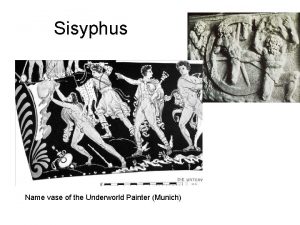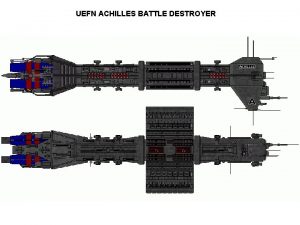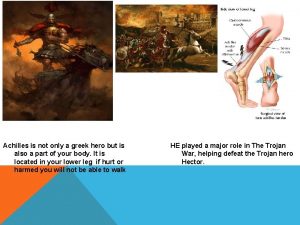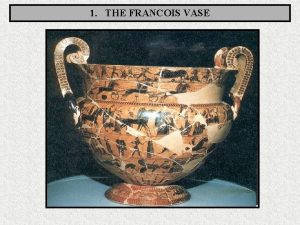Achilles painter Achilles Painter Lekythos Vase Lekythos Use




























- Slides: 28

Achilles painter

Achilles Painter Lekythos Vase: Lekythos Use: Storage of Oil Potter: unknown Painter: attributed to the Berlin Painter Date: 450 -440 BC Height: 38 cm Subject: A woman and her maid

Composition of Vase • Make at least four points about the composition of scene • Start at top and go down then go left to right. • Include specfic reference to the vase


Treatment of figure • In detail describe each figure

• At left, a girl standing in profile to right holding a box. She wears a diaphanous sleeveless chiton with overfold and kolpos. • She is drawn in profile her face is calm and expressionless which mirrors her mistresses. • Her hair mirrors her mistress dark and loosely tied in a bun at the back of her head.

• At right a woman standing in frontal view, with head looking to left, her left arm is extended downwards in a relaxed fashion. Her dark hair is loosely tied in a bun at the back of her head. She is wearing a loose fitting yellow sleeved chiton and red himation. Her face is calm and expressionless. Her feet are frontal and effectively foreshortened.

The Achilles Painter, • The Achilles Painter, working in the period between 450 and 425 B. C. , was one of the great painters of white ground lekythoi. • He was one of the foremost red-figure artists of the mid-fifth century B. C. His funerary lekythoi are among the most poignant and beautifully executed. • Was a pupil of the Berlin painter

How he got his name • He did not sign any of his works. • He is named from the subject a key vase, this is know has his name vase

Name Vase

The Name Vase • A solitary figure against a black background is a composition the Achilles Painter derived from his teacher, the Berlin Painter, as is the pattern used in the band underneath Achilles. The Achilles Painter favored it, as did other artists working in the Berlin Painter's tradition, including those in the Achilles Painter's workshop. The use of this motif helps one trace the Berlin Painter's workshop and his tradition during its seventy-five year history (ca. 500 -425 B. C. ).

Naming Vases • However, not all painters or potters signed all their work. Some seem never to have signed their vases, unless by chance signed pieces by these craftsmen have not survived. • Even in the case of unsigned vases, it is sometimes possible, through close examination of minute details of style, to recognize pieces by the same artist. • For ease of reference experts gave various nick-names to the anonymous painters whom they identified. • Some are called after the known potters with whom they seem to have collaborated - the Amasis Painter, for example, are named from the potters of those names. • Other painters are named from the find-spot or current location of a key vase, such as the Berlin Painters. A few, such as the Francois Painter, take their names their modern discovers • Others are named is from the subjects of key vases, such as the Achilles and Penthesileia Painters,

Achilles from Homer’s Iliad • • The leader of the Greeks, took Briseis away from Achilles This action sparked the central plot of the Iliad, for Achilles became enraged and refused to fight for the Greeks any further. He agreed to allow his friend Patroclus to fight in his place, wearing his armor. Patroclus was killed by the Trojan prince Hector. Achilles was overwhelmed with grief killed Hector. Then desecrated the body, dragging it behind his chariot around of Troy, and refused to allow it to receive funeral rites. Priam, the king of Troy and Hector's father, came secretly into the Greek camp to plead for the body, Achilles finally relented; in one of the most moving scenes of the Iliad, allowed him to take the body away.

Achilles in brief • He was the mightiest of the Greeks who fought in the Trojan War, and was the hero of Homer's Iliad. • Thetis held the baby Achilles by the heel and dipped him in the river Styx; everything the waters touched became invulnerable, but the heel remained dry and therefore unprotected ie achilles heel = weakness. • After the death of Hector, Achilles' days were numbered. He continued fighting heroically, killing Memnon (BERLIN PAINTER) and the Amazon warrior Penthesilia. • He reportedly fell in love with Penthesilia, the Amazon queen whom he killed in battle.

White ground technique • 1 st half of the fifth century • Usually funerary lekythos • But there are kraters, pyxides, and amphorae • Use of subtle shading, like a canvas

White ground style • In the late 500 s B. C. , Athenian potters began to cover the natural reddish color of their pottery with a highly purified clay that turned white when fired. Initially, artists applied this technique to a variety of shapes decorated with a wide range of scenes. Just before the middle of the 400 s B. C. , however, artists began limiting the use of this technique to a specific shape—the lekythos, a small oil container used in funerary ritual—and the decoration on the vessel shifted almost exclusively to funerary scenes. This change was due to the fragile nature of the white slip, which did not wear well but served the onetime use of a funeral quite nicely.

Development of White Ground • In Athenian pottery, by the late 6 th century B. C. the shape of the lekythos was standardised with a tall cylindrical body, a chimney-like neck and a swelling funnel mouth. • Black- and red-figure lekythoi were used for domestic purposes. But the so-called whiteground lekythoi, with their coating of a white slip and delicate outline figure drawing, became associated with funerary rituals. • Filled with precious oil, they were placed both in and on graves, for the benefit of the deceased.

Achilles Painter’s White-Ground Vases • He is best known for his white-ground lekythoi start a little later than the red-figure vases, the earliest coming from the decade 460 -450 B. C. , but last longer, continuing into the early 420 s. • Almost all the Achilles Painter's Early white-ground lekythoi have a scene with two women, termed by Beazley 'mistress and maid. ' A recent attempt to see all of them as connected with bridal preparations is unconvincing, since the circumstances for the setting and the identities of the two women vary, and some are clearly connected with funerary rites.

Funerary vases • This vase which depicts a maid and the deceased, exemplifies Attic white-ground funerary lekythoi at their finest. Funerary representations of the sixth century B. C. depicted the deceased surrounded by mourners. By the middle of the fifth century, the deceased was shown either as living or not at all.

Early Grave Stele • Mother with maid and children plaster cast 480470 bce late archaic

Comtempory Grave Stele • Ampharete with her grandchlid 430 -420 bce Kerameikos


Grave stele of a youth • Grave stele of a youth and a little girl with finial in the form of a sphinx 530 bce Archaic Inscriptions: [on the base] "to dear Me[gakles], on his death, his father with his dear mother set [me] up as a monument. "

Compare



• • The Otago lekythos has been assigned to his workshop. It shares the master's usual iconography on such vases, of a two-figure composition set around a tombstone, and uses pure line with little added colour. On the shoulder is a palmette design in which the central palmette has shrunk to a single petal. Below the shoulder runs a band of "stopt" meanders facing alternately right and left and interspersed with saltire crosses. This is a common meander for the Achilles Painter, but its presentation is relatively slipshod in comparison with the work of the Achilles Painter himself, as is some of the line work in the figured scene. On the body of the vase a woman and a warrior face each other across a tombstone. The woman stands to the left of the tomb and looks towards the man on the other side. She is dressed in a thin tunic which is belted with an overfold at the waist. Its apparent transparency was probably originally disguised by added colour. With her right arm she gestures to the warrior, while her left points to the foot of the tombstone, which is decorated with a ribbon and a wreath. On top of the gravestone stands a statue of a youth, draped in a cloak and posed in such a way as to echo the stance of the warrior to the right. This warrior is clad in typically Greek armour: over a short tunic he wears a decorated linen corselet, with long tabs to protect the lower abdomen and groin. His bearded face is covered by a crested "Thracian" helmet decorated, unusually on the neckguard, with the figure of a satyr. In his left hand he holds a large round hoplite shield and in his right a spear. The meaning of such tomb scenes is not always clear. Is the warrior dead? If so, are we to read the scene as a memorial to a dead warrior, killed in battle, but remembered by his wife in her imagination across the great divide of the tomb? At the time when this lekythos was produced in Athens, the city was at war with her Greek neighbours, and this period witnessed the greatest output of white-ground lekythoi with funerary scenes.

The Otago lekythos
 The achilles painter
The achilles painter Choregos vase
Choregos vase Achilles painter
Achilles painter Woman and maid vase
Woman and maid vase Archaic vase painting
Archaic vase painting Eurymedon vase
Eurymedon vase Inchidere spontana dsa
Inchidere spontana dsa Tertiary line of the ikebana representing earth
Tertiary line of the ikebana representing earth Oedipus and the sphinx
Oedipus and the sphinx Historical pots
Historical pots Tethrippon
Tethrippon The vase is
The vase is Euthymides belly amphora
Euthymides belly amphora There is no a flower
There is no a flower Vase tihedus
Vase tihedus Exekias achilles and ajax playing a dice game
Exekias achilles and ajax playing a dice game Early american floral designs
Early american floral designs Black figure vase
Black figure vase Our class won the competition
Our class won the competition Groupe de maintien de pression fonctionnement
Groupe de maintien de pression fonctionnement Kirstin was once teased for being heavy
Kirstin was once teased for being heavy Vase ulysse et les sirènes british museum
Vase ulysse et les sirènes british museum Theseus and the minotaur vase
Theseus and the minotaur vase Sosibios vase
Sosibios vase Najmanja dopuštena dubina utora ljetnih guma
Najmanja dopuštena dubina utora ljetnih guma Vegetalo
Vegetalo Sappho and alcaeus vase
Sappho and alcaeus vase サントリー美術館 vase with grasshopper design
サントリー美術館 vase with grasshopper design Vase level 1
Vase level 1


